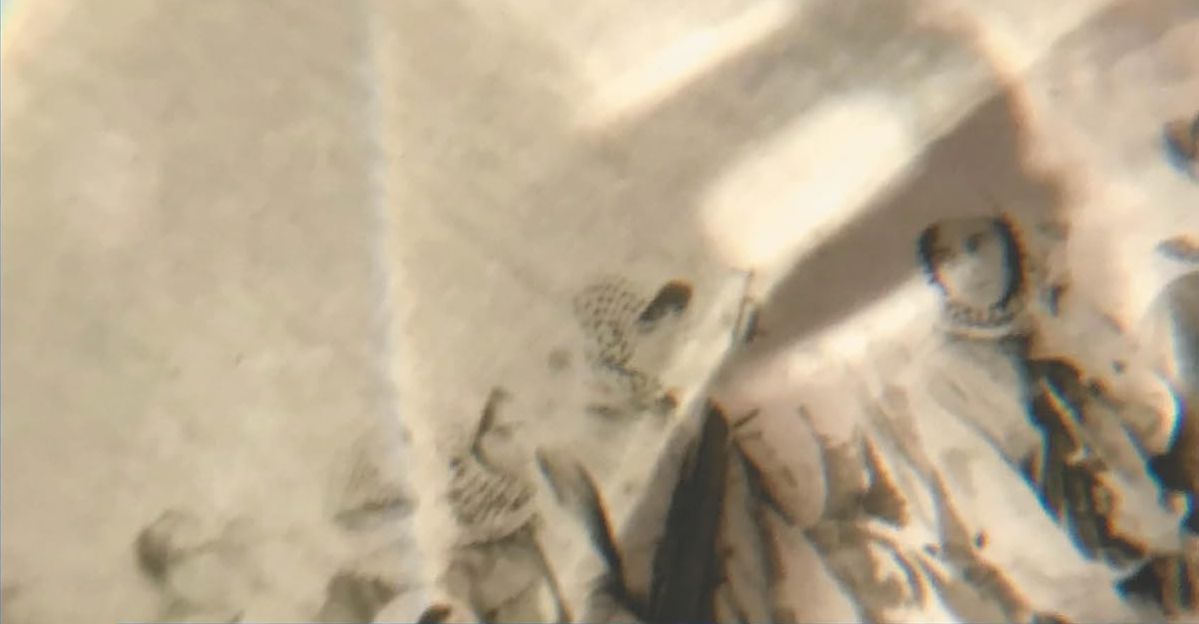A happy accident or a flash of inspiration, the audience seating for Ryan Trecartin’s 6 Movies, a selection of the artist’s video-works now screening at the Art Gallery of Western Australia, takes the form of two curved vinyl couches, one on either side of the room. The layout, evocative of a gameshow with opposing teams, places the viewer in the unstable role of both judge and contestant.
The game is ultimately one of endurance: the video-works total six hours screened back to back, and experiencing them is akin to stumbling upon a raucous sorority party, and fighting the urge to simply shut the door. While many of my fellow gallery-goers bowed out of the competition after mere minutes, I persevered, irradiating elitist triumph. Yet the truth was that I too felt alienated by the hyper-verbal characters on the screen before me; that their private speech codes and aspirational posturing made me feel old.
Considered by many critics to be the most significant video artist of his generation, the LA-based Trecartin throws the viewer, without prologue, into a world where the worst fate is precisely this: to become obsolete.
In CENTER JENNY (2013), a group of young women (and occasionally men) in blonde wigs and collegiate jumpers are vying to be the central Jenny. Surrounded by ‘witnesses’ who record the action on hand-held cameras and I-phones, these women are enlivened by a singular anxiety: there will always be another Jenny to take your place. Policing each other with epithets drawn from the toxic recesses of social media (basic bitch; vintage slut), the mise en scѐne for their sociopathy is determinedly lo-fi: populated largely by his own acquaintances, Trecartin’s videos have the air of an amateur improvisation class, replete with askew wigs, and wardrobe malfunctions.
This appears as much an aesthetic choice as an economic one, the influence of Cindy Sherman palpable in the gap between these aspirants’ self-image and their actual cosmetic grotesquery; in the understanding of gender as a precarious performance. The men, for their part, move with the natural grace of cyborgs, indulging in an up-to-the minute form of mansplaining: ‘educating’ the women on the Human-era that, they explain, preceded this one. Eerily vacuous with the help of opaque contact lenses, the Jennys prove uncomfortably vulnerable to their allure. The further she gets from the Human era, one pronounces, the better she appreciates ‘sexism as a style’.
At times this post-Human era seems little more than a sly take on the postmodern, where anything is fair game for aesthetic appropriation and the idea of false consciousness – once a feminist stalwart – is all but dead. As meaning is emptied out, traditional hermeneutics become retrograde (‘I no longer look for meaning in things’) and ‘narration is the devil’. What vestiges of plot remain are not conveyed through conventions such as dialogue, but must be salvaged, somewhat quixotically, from the aural equivalent of simultaneous updating twitter feeds; a kind of non-communication punctuated by corporate jingles, buzzwords, bragging disclosures. A consummate editor, Trecartin’s work has a strong musical component: as another YouTube-style appeal to camera morphs into auto-tuned dirge, there is a palpable sense of the auteur as old-school DJ, sampling the ephemera of an age. Performers are mobilised less as actors than as ventriloquist’s dummies, fed their lines at the moment of shooting to ensure their performances remain naïve, uncorrupted by dramatic motivation or character arc. One Jenny, tellingly, compares linearity to having ‘night goggles’ on.
The collapse of a temporal framework is also apparent in Item Falls (2013), which takes the form of an audition game whose players aspire to get to ‘the next level’ (or post – asif), oblivious to the fact that the ‘levels’ ultimately lead nowhere; that they are trapped in some kind of perpetual bardo. In fact, rather than progressing in a sequence, each of these six movies plays like an ante room of the one claustrophobic nightmare, as references and characters recur.
It is an atmosphere that calls to mind Walter Benjamin’s analysis of the lamentation play. For Benjamin the lamentation play dramatised ‘the collapse of sequence into simultaneity’, depicting a world where ‘time no longer bears the promise of eventual remedy’, a world bereft of eschatological hope. Yet rather than moving inconsolably through a world bereft of meaning, Trecartin’s characters are defiantly post-mourning: why fear death, when life is a mere game, the players but avatars? As the audition in Item Falls begins to assume the form of a dystopic reality TV-show, one of the contestants announces cheerfully, ‘they’re gonna shoot us in an hour!’
For Benjamin, the index of mourning in the lamentation play was pantomime, that which ‘relies on the gesture, the one that has, as it were, lost its referent, that operates through a non-mimetic semiotic of its own’. In Trecartin’s world, the gestures are large, aggravated, but they similarly fail to mean. In Sibling Topics (section a) (2009), the artist cameos as a bereaved daughter who simulates mourning by spraying artificial tears in her eyes. Elsewhere, camouflage gear is reappropriated as rave gear; one Jenny brags insensibly, ‘my parents owned the war.’ As the credits roll a young man spins an arrow shaped bill-board with mute, rhythmic grace. An art traditionally used to direct customers to a retail business, the sign guides us nowhere; its faces are blank.
Whether this moment alludes to a broader political or moral vacancy, it certainly highlights Trecartin’s privileging of the grammar, the syntax, of a cultural moment; his interest in the medium rather than the message. In an interview with Jennifer Lange, Trecartin professed a love for ‘the idea of technology and culture moving faster than the understanding of those mediums by people. It’s like the jumper being jumped before the onset of ‘jump”.’ In this regard, the artist seems happy for his work to be a symptom rather than a diagnosis.
Promotional material for these screenings invites the viewer to be immersed in the ‘ecstatic poetics’ of Trecartin’s practice, and his highly incantatory, syntax-disrupting works certainly evoke a rapture, the poet possessed by a muse. Yet the pastoral spirit that traditionally enlivened the classical poet has here been supplanted by a technological one, resulting in audio-visual poems that stutter forward like corrupted feeds. As the poet Eileen Myles noted in her Paris Review interview with Ben Lerner: ‘You may not use social media, but it’s using you. You’re writing in tweets, like it or not.’
Conscious of the liminal, contested status of his works, Trecartin has one of his performers ask, ‘is this a poem?’ At first glance his sensibility seems less of a poet than of a satellite, cruising indiscriminately through the ephemera of contemporary culture and collecting space junk. But his maximalist artefacts have in fact been carefully curated, buzzwords and empty aphorisms rhythmically mounted to create uncanny resonances. As Myles suggests:
Every kind of technology changes the entire structure of the culture and that’s why literary is such a cloying term. It’s archaic to insist that the book be a book and even to behave as if there is a realm that is ‘literary’ that refers only to letters.
Of course, shape-shifting, genre-destabilising Trecartin can’t help but undermine his work’s more literary pretensions: as one of his performers interjects, ‘this reminds me karaoke’.
The reference to karaoke is telling: Trecartin’s future appears decidedly retro, his occasional use of animation dating from somewhere back in the Atari years. Such anachronisms are wilful, hinting that this future, with its hyper-linked, multi-screened pageant of endless becoming, is in no way coterminous with the present. The narcissism on show here is simply more hyperbolic, more frenzied; a tongue-in cheek warning, perhaps, from this ghost of the future past. One gets the sense Trecartin is playing on the negative discourse of ‘YouTubing millennials’ as much as making a serious indictment. Frustrating any moral-making imperative, he appears in high-camp mode and directly addresses the camera: ‘this is clearly a double bluff’.
The only thing really clear is that we are in the presence of a repellent kind of genius. These video-works are compulsively alienating; emerging finally from the bacchanalian onslaught, I felt strangely compromised, as though I’d just participated in some dubious rite. A vacuous celebration; or a celebration of vacuity? Precisely the kind of Day-Glo koan that one of Trecartin’s lost souls would utter.
6 Movies is screening at AGWA until 8 of May.
Image: still from Center Jenny.
–



